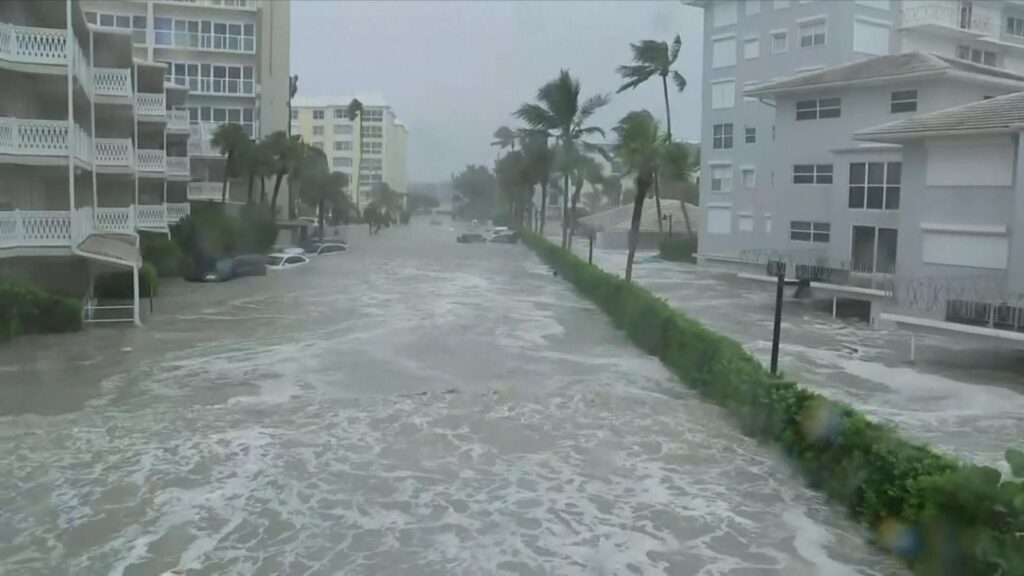U.S.
Hurricane Milton Strikes Florida with Ferocious Winds and Flooding
Hurricane Milton strikes Florida, making landfall in Sarasota County as a formidable Category 3 storm. Tornadoes were unleashed, causing extensive damage. The storm delivered significant storm surge along the coastline, accompanied by torrential rains. Streets became inundated, making travel nearly impossible for residents and emergency services. Powerful winds even tore off the roof of Tropicana Field in St. Petersburg.
Extensive Damage and Ongoing Rescue Efforts
The destruction is widespread and devastating as Hurricane Milton strikes Florida. Search and rescue operations are actively underway in affected areas. Over 42 rescues have been reported so far. Additionally, more than 3 million utility customers remain without power. Emergency services are working tirelessly to restore normalcy across the region.
Florida Dodges the Worst-Case Scenario
Despite the devastation, Governor Ron DeSantis stated at a press conference that the state avoided a worst-case scenario. Furthermore, a shift in Milton’s trajectory spared Tampa Bay from the storm’s worst fury. Additionally, AccuWeather meteorologist Adam Douty noted the storm was positioned far enough south. As a result, this positioning prevented a significant surge into Tampa Bay. Overall, these factors contributed to a more manageable outcome for the region.
Significant Rainfall and Flooding
Nevertheless, the storm surge and rainfall remained formidable throughout the region. By 10 p.m. on Wednesday, Albert Whitted Airport recorded 16.6 inches of rain. Consequently, severe flooding was reported in multiple areas. In fact, flooding extended as far south as Naples Bay, over 100 miles from landfall. Overall, these conditions have significantly impacted communities across the area.
Tornado Outbreak Reports
The US Storm Prediction Center received at least 38 reports of tornadoes. Dan DePodwin, senior director of forecasting operations for AccuWeather, noted that Florida appeared to have experienced a substantial outbreak along the Interstate 95 corridor, spanning from Fort Lauderdale and Palm Beach to Cape Canaveral and the Space Coast area.
Projected Damages from Hurricane Milton
Chuck Watson, a disaster modeler with Enki Research, estimates that damages and losses from hurricane Milton strikes Florida could range between $60 billion and $75 billion. By 8:30 a.m. on Thursday, the number of homes and businesses without power had increased to 3.3 million. Melissa Seixas, president of Duke Energy Florida, indicated that the company had recently replaced numerous transformers destroyed by Hurricane Helene just two weeks prior, leaving equipment vulnerable again.
Power Restoration Efforts Underway
Florida has tens of thousands of linemen on standby, ready for power restoration. According to DeSantis, they will act promptly once conditions permit. Furthermore, these teams are strategically positioned throughout the state. As a result, they can respond quickly to restore power to affected areas. Overall, this preparedness demonstrates the state’s commitment to minimizing disruptions after the hurricane.
Federal Response and Climate Change Concerns
President Joe Biden received a briefing on Thursday morning regarding the initial impacts from Homeland Security Advisor Liz Sherwood-Randall and FEMA Administrator Deanne Criswell. In a post on X, he urged those affected to remain indoors and avoid dangerous situations caused by road washouts, downed power lines, and debris.
The Influence of Climate Change on Hurricane Patterns
Watson from Enki Research noted that Milton’s flood-producing heavy rains continue a trend of increasingly “wetter storms,” further supporting evidence that climate change is impacting hurricane characteristics. A warmer atmosphere can retain more moisture, leading to heavier rainfall.
Abnormally warm waters in the Gulf of Mexico influenced Milton’s atypical west-to-east path. Scientists predict that such erratic storm behavior may become more frequent as climate change progresses.

Joe Biden Fades but His Bureaucrats Remain
Despite Kamala Harris replacing Joe Biden as the Democratic Party’s presidential candidate, Biden remains a pivotal figure…
Economic Implications for the Insurance Industry
Bloomberg Intelligence analyst Charles Graham indicated that Milton’s downgrade to a Category 3 storm before landfall likely means the insurance and reinsurance sectors, including firms like Munich Re and Swiss Re, will avoid a worst-case scenario of over $100 billion in losses. While the economic and human toll from flooding and storm surge will still be significant, it will take time to assess the full extent of the costs.
COP29 and Climate Finance Challenges
Next month, delegates from around the globe will convene in Baku, Azerbaijan, for COP29, where crucial financial questions will arise. Can wealthy nations meet developing countries’ demands for up to $1 trillion annually in climate financing?
Avinash Persaud, special adviser on climate change for the Inter-American Development Bank, has dedicated his career to discovering ways to mobilize global markets for climate financing. He explains to Akshat Rathi why he views climate change as an “uninsurable” event and discusses the financial instruments and commitments that could assist poorer nations in transitioning to sustainable energy and adapting to a warmer environment.

Seize this remarkable opportunity for information and empowerment. Enroll in our Digital News Combo Package today to join a community that relies on The Washington Post and The NY Times for daily insights.

